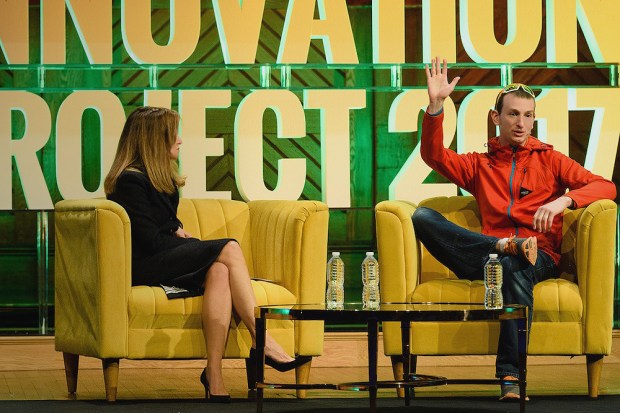LevelUp Chief Ninja Talks Order-Ahead Future

In just a few short years, mobile order-ahead capabilities have become an essential feature across a rapidly growing number of quick-service restaurants (QSR) in the U.S.
In a fireside chat at Innovation Project 2017, PYMNTS’ Karen Webster and Seth Priebatsch, Chief Ninja of mobile payments, loyalty and now order-ahead platform LevelUp, talked about the latest QSR adoption trends, why the feature has become so popular so quickly among brands and consumers alike, and what the future of order-ahead holds for the QSR space and beyond.
LevelUp’s move to enable mobile order-ahead for its merchants represented a bit of a pivot from its prior functionalities. Though not nearly as much as the pivot from its early scavenger hunt days to mobile payments, Priebatsch said, noting that it aligns with the startup’s overarching goal to enable merchants to digitally engage their customers.
The decision to break into mobile order-ahead came from a combination of merchant demand and watching the data.
Of the former, requests to enable mobile order-ahead was one of the most consistent (not to mention persistent) feedback the company received from their merchants — especially after Starbucks rolled out their solution.
Testing their first native order-ahead solution at one of their merchant locations, LevelUp had what Priebatsch lightly called a “Netflix moment.”
“We’re a lot smaller than Netflix,” Priebatsch clarified, “but what the data told us was that something that was going to cannibalize our own business very clearly.”
Industry-wide, mobile order-ahead has grown by leaps and bounds. In 2015, order-ahead solutions had been deployed at 60,000 locations across the U.S., Priebatsch told Webster. Through 2016, it had grown to feature in 180,000 locations.
By the end of this year, projections indicate that ordering ahead will scale to more than 300,000 locations nationwide. To put it another way, by the end of 2017, order-ahead could be in 40 to 50 percent of all QSRs, coffee shops, etc., in the U.S.
Priebatsch made an even bolder prediction for 24 months out, saying, “We might see more restaurant orders happening from the phone before people walk in the door than at the counter in the next 24 months.”
It’s an aggressive projection, he noted, but the numbers hold when tracking on a merchant-by-merchant basis. At the least, Priebatsch expects this projection to hold true for LevelUp’s merchants.
As to why mobile order-ahead has become so popular in the QSR space, it’s actually very simple.
On the consumer end, it solves some major pain points.
“Society as a general trend is not getting more patient,” Priebatsch said. “Even 140 characters of a Tweet is a stretch sometimes. Waiting in line those extra minutes is painful, and the consumer demand is really potent.”
This would explain the rapid consumer adoption. Starbucks, for instance, went from zero to having one-third of all mobile interactions comprised of order-ahead activity.
On the restaurant end, the benefits are manifold.
QSRs are complex operations in that they handle a real-time manufacturing facility with a variety of materials and personnel, noted Priebatsch, not to mention hundreds, if not thousands, of hungry customers on a daily basis.
“But what they want is really simple,” he said. “They want more money and fewer costs. Order-ahead turns out to be a panacea for that.”
For instance, the average value of an order-ahead ticket comes in 7 to 10 percent higher than the average in-store ticket — even accounting for the fact that mobile in-store payment is also higher than in-store cash.
Additionally, the labor costs associated with order-ahead turn out to be around 30 percent lower. They’re able to be more efficient and mechanize the process. And there isn’t the time spent in conversation with the customer; when an order comes in digitally, the customer has already customized it. Priebatsch went so far as to say that mobile order-ahead is as close to a non-checkout restaurant experience as you can get.
The opportunities for automation afforded by mobile order-ahead extend beyond the meal preparation process. Of LevelUp’s 100,000 active daily users, one-third of them order the same menu item in the same 15-minute window from the same restaurant more than once a week.
As more locations adopt mobile order-ahead, the difference maker in the QSR space is going to be how effectively enterprises use customer intelligence, Priebatsch said, and how they leverage using that through loyalty, rewards and predictive ordering, among other things.
“People are deeply habitual,” he said. “If you’ve got an order-ahead experience, you shouldn’t wait for the consumer to open your app. [You can notify] them via push notification to say, ‘It’s 11:45 a.m., and you probably want a burrito. We can have it ready for you in eight minutes — come on by.’”
These capabilities could also naturally extend to enable the broader retail space, Webster noted. While LevelUp has begun to explore these opportunities, it’s largely maintaining its focus on the QSR space for the time being.
“We’ve got to pick our battles carefully,” Priebatsch said, “but we have started to partner with some grocery chains and one or two retail establishments here and there.”
That said, he noted that it’s almost inevitable that order-ahead will break into the broader retail space. It may just take longer than the adoption seen in QSRs.
“Most retail establishments are still fighting the eCommerce battle,” he said. “For restaurants, eCommerce is delivery, which is a known concept. But for the in-store retail experience — there’s a lot of room for innovation there. Once Amazon Go has their locations up and running in every major city, every retailer is going to try to meet that challenge.”
In the QSR space, 90 percent of interactions still happen in physical locations, which means there’s major growth still to come for mobile order-head.
As the options become ubiquitous in the next few years, Priebatsch made one final conjecture for QSRs: “I think we’re going to look at people waiting in line in two years and think: That’s weird.”
